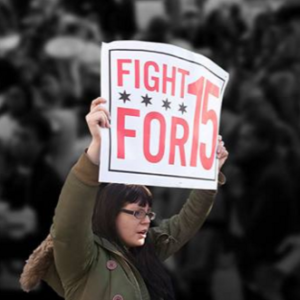The Fight for $15 movement protested in over two dozen state capitals Monday in response to a low-wage worker dying.
Fight for $15 organizers setup rallies and vigils at 28 state capitals across the country. Participants marched through the streets of cities like Dallas, Texas. They also held church services in cities, including Chicago, Illinois. Movement organizers dedicated the day to a low-wage worker who had died.
“The national day of action will be dedicated to former Missouri McDonald’s worker Myrna De Los Santos, who died on Aug. 27 at the age of 49 due to complications from diabetes,” Fight for $15 said in a press release. “A condition that went untreated because her $8 per hour wage wouldn’t cover basic health care.”
The Fight for $15 movement has been at the forefront of the minimum wage push since it started in 2012. The movement is primarily backed by labor unions like the Service Employees International Union (SEIU). Those opposed argue raising the minimum wage to $15 an hour would actually be detrimental for many workers who would lose their jobs.
“SEIU is directing today’s protests because they are desperate to boost their shrinking membership rolls,” America Rising Squared Communications Director Jeremy Adler told InsideSources. “Repeated studies, including a recent state-by-state breakdown, show that SEIU’s efforts to dramatically hike the minimum wage will eliminate millions of jobs for hardworking Americans who need them most.”
America Rising is a nonprofit research group that promotes conservative policies. It warns that seven million jobs would be lost if lawmakers in those 28 states alone raised their minimum wages to $15 an hour. Economists have released countless papers debating whether the policy is a good idea.
The Fight for $15 and other supporters argue the policy is a great way to lift low-wage workers out of poverty. Critics warns it will actually hurt the poor by reducing employment opportunities. Economists have been fairly split on the minimum wage but generally agree at least some job loss is a risk.
The National Bureau of Economic Research and The Heritage Foundation found the increase will have a significant impact on employment. They found the risk is especially bad for young and low-skilled workers. The University of California, Berkeley found any losses would be marginal compared to the potential benefits.
The Associated Press first reported the movement planned to hold protests in state capitals across the country. Protesters demanded politicians support a moral policy agenda that includes higher wages, union rights and better healthcare for workers. Protesters also presented lawmakers in each state with a declaration in support of the policies.
The Fight for $15 noted protests took place in states including Connecticut, Georgia, Illinois, North Carolina, Tennessee, Texas, and Virginia, among others. New York and California are currently the only states to have passed a $15 minimum wage.

